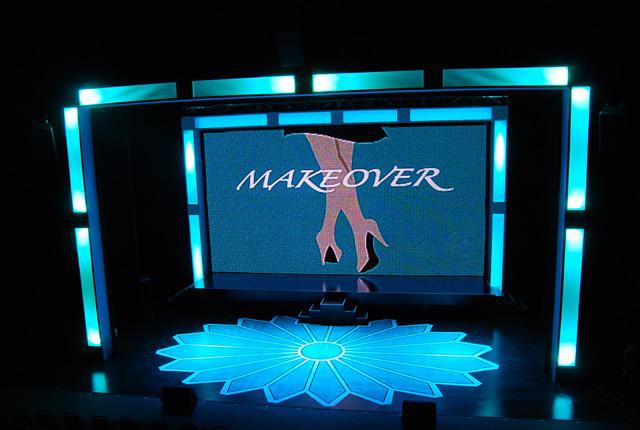Set and Media Design Part 2
This blog series offers a multi-disciplinary approach to achieve the best practices for collaboration in the creative and production process of incorporating digital media into live performance.
As a designer, it is my bias in most theatrical settings to want to project onto actual architecture vs. screens. However, screens are often what are chosen by the director and the scenic designer. I cannot tell you how many media designers I have spoken to who prefer to project onto actual architectural elements rather than screens. Yet, we often lose this battle because it means the set designer would have to design and the shop would have to build actual set pieces. I have heard set designers say the budget won’t allow for the build of detailed set pieces. I often ask, “What would be there if there was no media? Why are you building a carefully considered, realistic world that has a giant white screen in it?” It rarely dawns on other departments that a giant white screen with nothing on it looks pretty awful until they are sitting in the theatre. The answer? Put projections on it. The results? An entire show with projections on a giant screen, if it is dramaturgically correct or not.
But I think it goes beyond the practical issues of budget and delves into another realm. There is a belief system that assumes media is only projections because we typically see projections on a screen at the movies, and during PowerPoint presentations. So, everyone assumes that media should be on a screen. Don’t get me wrong, I like screens. The correct screen will make my content look great. But is that the right choice for the narrative in a theatrical context, for meaning making?
Beyond meaning making, most theatres cannot afford real projection screens, especially giant rear projection screens. So we are often forced to use poly-cycs or muslin as screen surfaces, which are not ideal surfaces for projections. They absorb more light, making the projections less bright and that is a big deal! Very often, media designers already use projectors that don’t have enough lumens to cut through all the light onstage. Any choice where we are losing lumens is a significant choice. These types of materials were not created or treated to hold projections, so they don’t have the proper type of reflective quality, and they absorb more light. These materials are more porous than screens, so often times you can see the light source from the projector when rear projecting, which is not pretty. It’s often painful for audience members to stare at a projector light source. It is also hard to get a crisp image on these surfaces; so, the images may look a little washed out in terms of color and/or soft in terms of focus.
It is always a good idea to leave time in the schedule for testing projection surfaces. This means the team has to research surfaces, order a sample and conduct a projection test on said surface, which takes time. Add it to your schedule and consider this when you are making choices.
It is crucial to remember that all your decisions as a scenic designer have rippling effects. When designing, take responsibility for how your design helps shape the dramaturgical meaning of media design.
Self-emitting Media Gear
What about TV’s, LED walls, or curtains? Who decides what type of self-emitting video equipment will be used? The Set Designer or the Media Designer? Or, gulp, the Lighting Designer? (My next post will breakdown the relationship between lighting and media design). Of course it depends on the type and scale of the project. But ideally, it is a collaborative process because the physical presence of an object crosses departmental lines. It can be a very different method of creating content, and a different method for programming content for an LED curtain than it is for a screen, which must be kept in mind when making these decisions. Remember the presence of an LED wall conveys a different meaning to the audience before any content is on it. The medium (screen, architecture, LED wall, etc.) that conveys the message (content) also conveys meaning unto itself. For example, should there be an LED wall in a realistic play set in 1950 when LED walls did not exist?

Staging and Floor Treatment
Other vital essentials the scenic designer has to consider are how the media is being used in the show and staging. Are actors interacting with the media or is it purely scenic? What are the actors’ relationship to the media content and architectural medium? Will actors be staged right next to projected images? These questions matter because of lighting. “Oh, that’s not my department!” Wrong, your choices as a set designer also impact the lighting designer. If there is an actor standing one foot away from a projection surface, the lighting designer needs to light that actor and in doing so, will also spill light onto the projected image, thus washing it out. So, it is imperative that these conversations be had prior to the scene design going to the shop for build. The scenic designer must account for acting areas near projected elements and allow ample space for lighting to be able to illuminate the actor, without overpowering the projections. Your decisions as a set designer affect the staging, lighting, and media.
Also remember that light will bounce off the floor and onto a projection surface. This means that the floor treatment becomes critical, so that bounced light doesn’t wash out projections or LED panels. While it seems instinctual to paint the floor a flat dark color, I have found that a darker color with a little bit of sheen to the paint is actually better.
3D Models
For most corporate entertainment projects and big budget theatre productions, the set designer or production designer provides a digital 3D model of the set. So, why isn’t this the case in most theatrical scenarios? Especially since it is hugely helpful for the entire team—it allows the media and lighting designer to previsualize their work onto the actual set. It is much different to try to visualize how a movie playing on QuickTime on your laptop will look on the set vs. if you can actually see a QuickTime movie of the content playing on a digital 3D model of the set. It is the set designer’s responsibility to supply the rest of the creative team with this essential asset. In 1950, set designers built real-world miniature models for the team to be able to use for basic previsualization. With all the various CAD software, it is increasingly easier to take a design and create a 3D digital model. In my humble opinion, this is what all students studying scenic design should learn in University and is the best work flow method for previsualizing and designing shows. It not only helps the media designer, the director, and the entire team previsualize, but it also allows the media designer to get a head start on solving related issues (e.g. content creation, image warping, mapping, blending, projector placement, etc.), which makes for a smoother and quicker process once in the theatre.
Playing Together Nicely in the Sandbox
In conclusion, it is crucial to remember that all your decisions as a scenic designer have rippling effects. When designing, take responsibility for how your design helps shape the dramaturgical meaning of media design. Advocate for having a media designer join the team as early as possible, and remember that we are a team striving to create a cohesive world for characters and story to inhabit.
Up Next: Lighting and Media Design










Comments
The article is just the start of the conversation—we want to know what you think about this subject, too! HowlRound is a space for knowledge-sharing, and we welcome spirited, thoughtful, and on-topic dialogue. Find our full comments policy here
I am writing a paper in my english class about how to make a production run smoothly with the incorporation of projections and a media designer. You are helping me out so much, so thank you.
Glad I was able to shine some light on the process.
Har Har Har. ;)